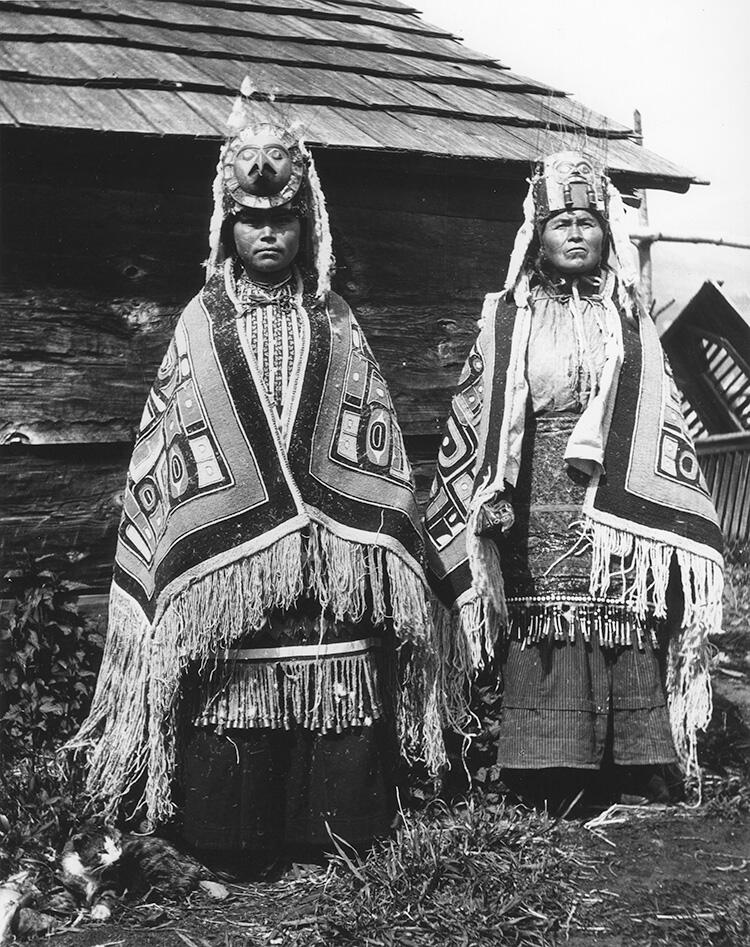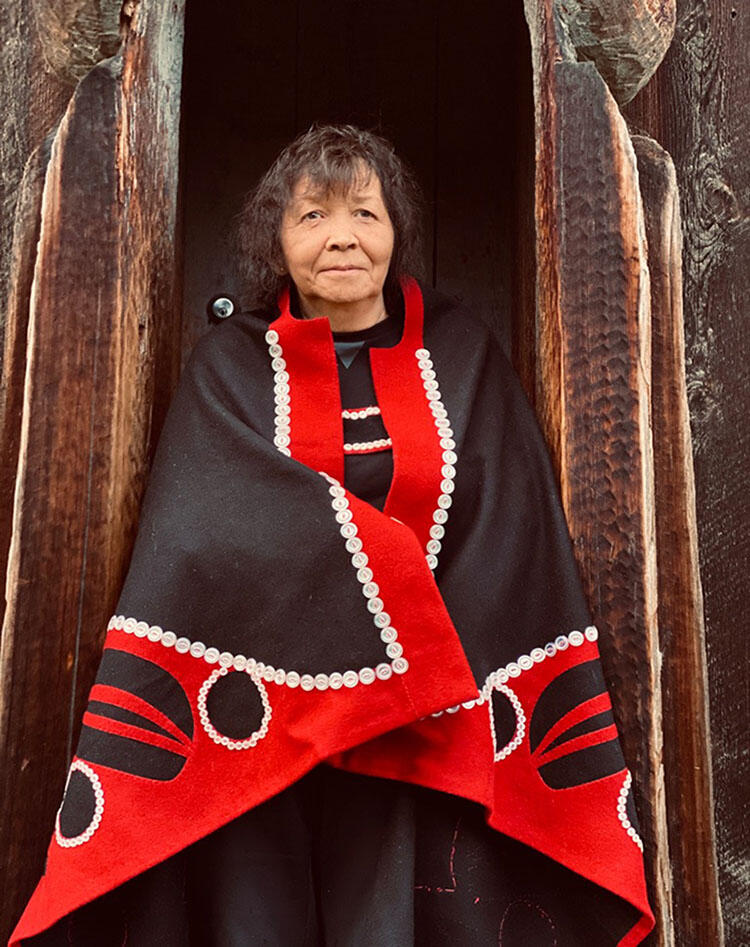Gitxsan
Matt Shanley/AMNH Anthropology catalog 16.1/602
Selected features from the Northwest Coast Hall.
“Gitxsan” translates to “people of the river of mist,” referring to the Skeena River. The Nisg̲a’a, Tsimshian, and Gitxsan are neighbors along the Skeena and Nass Rivers. These Nations share many traditions, and their languages are closely related.
Matrilineal Society
Rafferty Baker/CBC Licensing
In Gitxsan society, lineage descends through women. A female Chief typically chooses an heir from among her children or her sister’s children. A male Chief’s heir is chosen from among his sister’s children. The passing down of Chiefly names, as well as property and responsibility, has remained consistent, following the matrilineal system of genealogy.
 Elaborate ceremonial dress shows the high social status of this Gitxsan mother, Mrs. Richard Douse (right), and daughter, Mrs. Fred Good (Maggie), Frog Clan, Wilps Gamlaxyeltxw, photographed in 1910.
Elaborate ceremonial dress shows the high social status of this Gitxsan mother, Mrs. Richard Douse (right), and daughter, Mrs. Fred Good (Maggie), Frog Clan, Wilps Gamlaxyeltxw, photographed in 1910.University of Washington Libraries, Special Collections, NA3443
 Dorothy Smith Lattie received the Gitxsan name Wii Gaak when she became a Wolf Clan Chief, Village of Gitanmaax, in 2020.
Dorothy Smith Lattie received the Gitxsan name Wii Gaak when she became a Wolf Clan Chief, Village of Gitanmaax, in 2020.Ando’ohl lax̱ ha | Nathan Combs, Gitxsan Nation
daxgyet | a Chief's authority - In Gitxsanimax̲, the language of the Gitxsan people, this word conveys the strength of the people as well as a Chief's power and authority.
Traveling Between Worlds
Traditional doctors were called halayt, a word that refers to their ability to move between the spirit realm and the physical world. A shaman entered a trance-like state to call on spirit helpers for assistance in healing the sick and easing hardship among the people.
Canadian Museum of History, VII-C-1156, D2005-09799
Shamanic power tended to run in families. People born with healing powers worked with proven halayt to strengthen their abilities. Ultimately, the power to cure was gained through a vision quest taken alone. The last Gitxsan shaman practiced in the 1960s.
Am Miiluxw Luulak | Naxnox Mask
In the worldview of Tsimshian, Nisg̲a'a and Gitxsan people, supernatural spirits called naxnox inhabit all the world. A few exceptional people are able to forge an intimate connection with a naxnox. The spirit then acts as a guardian to help bring success in life. The mask above represents a naxnox in the form of an old woman wearing a large labret on her hinged lip.
Critical Role of Women in the Gitxsan Community
[Xsim Ganaa’w | Laurel Smith Wilson speaks to an off-camera interviewer]
XSIM GANAA’W | LAUREL SMITH WILSON (Culture Keeper and Consulting Curator) : You certainly understand your role as a woman in the Gitxsan system. It's equal to men and always has been. Women can be chiefs and are today.
[An archival black and white photo of a Gitxsan woman and a young child.]
XSIM GANAA’W | LAUREL SMITH WILSON: So, I would say throughout the centuries,
[Xsim Ganaa’w | Laurel Smith Wilson speaks to an off-camera interviewer]
XSIM GANAA’W | LAUREL SMITH WILSON: …a woman's role in Gitxsan society is very honored and always has been because she's critical to the well-being of her village.
Artist Spotlight: Sug-ii-t Looks | Yolonda Skelton
Sug-ii-t Looks | Yolonda (Loni) Skelton is a fashion designer and textile artist from the Gitxsan Nation. Skelton says that, “When people wear my pieces, it’s their history, wrapped around them, to empower and ground them in their culture."
Her Killer Whale Chilkat Wrap is featured in the Generation to Generation exhibition in the Northwest Coast Hall.
Matt Shanley/© AMNH
I made this robe for my maternal grandmother, the late Lily Jackson, Na-gwaa. We are from the House of Hax-be-gwoo-txw, the Fireweed Clan, and we use the Killer Whale crest. She was a Chief—so I wanted her to have something that represented who she was in the modern day and also showed that she had that status. And I wanted a piece she could wear anywhere, not just to the feast hall.
—Sug-ii-t Looks | Yolonda (Loni) Skelton, Fashion designer / Textile artist
Gitxsan, Fireweed Clan, House of Hax-be-gwoo-txw, Burnaby, British Columbia
More Resources
Gitxsan Consulting Curator
Xsim Ganaa'w | Laurel Smith Wilson
The Museum thanks Xsim Ganaa'w | Laurel Smith Wilson for the Gitxsanimax̲ words included on this site.